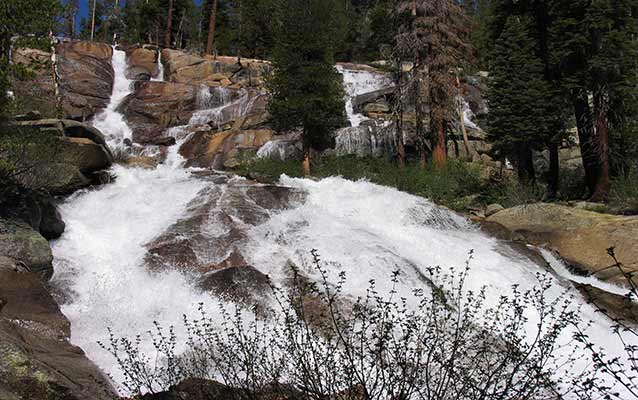Last updated: June 18, 2015
Lesson Plan
Climate Science in Focus: Data and Tools

- Grade Level:
- High School: Ninth Grade through Twelfth Grade
- Subject:
- Science
- Lesson Duration:
- 60 Minutes
- Common Core Standards:
- 9-10.RST.1, 9-10.RST.2, 9-10.RST.5, 9-10.RST.7, 9-10.RST.9
- Additional Standards:
- HS-ESS2-4
HS-ESS3-1 - Thinking Skills:
- Understanding: Understand the main idea of material heard, viewed, or read. Interpret or summarize the ideas in own words. Applying: Apply an abstract idea in a concrete situation to solve a problem or relate it to a prior experience. Analyzing: Break down a concept or idea into parts and show the relationships among the parts. Evaluating: Make informed judgements about the value of ideas or materials. Use standards and criteria to support opinions and views.
Objective
Students will use scientific data on streamflow from the Sierra Nevada to analyze snowpack and draw conclusions about the changing climate. Students will be able to predict changes that will occur to the Sierra Nevada snowpack if the climate change continues, and predict the changes that will result on the biosphere due to climate change.
Background
The Earth consists of four systems: the atmosphere, hydrosphere, geosphere, and biosphere, which are interconnected. Changes to one part of the system can have consequences on the others. Changes to global or regional climate can be caused by changes in the sun's energy output or Earth's orbit, tectonic events, ocean circulation, volcanic activity, glaciers, vegetation, and human activity.
Water is essential for life on Earth. Relative water availability is a major factor in designating habitats for different living organisms. In the United States, things like agriculture and water rights are hot topics. Current models predict that average global temperatures are going to continue to rise even if regional climate changes remain complex and varied. These changes will have an impact on all of Earth's systems.
Studies have shown that climate change is driven not only by natural effects but also by human activities. Knowledge of the factors that affect climate, coupled with responsible management of natural resources, are required for sustaining these Earth systems. Long-term change can be anticipated using science-based predictive models, making science and engineering essential to understanding global climate change and its possible impacts.
National Parks can serve as benchmarks for climate science trends and effects over time because they are protected areas void of human influence. Understanding current climate trends will help set students up to be successful in interpreting and engaging in discussions about climate change, which will lead to informed decisionmaking.
Preparation
Teachers will need access to the internet, a computer or laptop, and projector to play the videos for the class.
Write the following questions on the board or projector so the all students can see them:
How has climate change influenced human activities? How could Mammoth Lakes(or your community) be affected if the climate continues to change?
Print out one Excel Data Packet for each group if computers are unavailable. If computers are available, each group can view the data on a computer with Microsoft Excel.
Prepare the following videos:
A Way Forward: Facing Climate Change
California Department of Water Resources: Snow Surveying (.wmv file)
Materials
This pdf version of an Excel file provides data from the streamflow monitoring site at Pohono Bridge in Yosemite National Park. This is a sample of Sierra Nevada streamflow data, although other data can be found online.
This resource brief talks about why and how the National Park Service monitors climate at Devils Postpile National Monument
Download Weather and Climate Monitoring at Devils Postpile National Monument
Lesson Hook/Preview
Briefly discuss the following questions: How have climate changes influenced human activities? How could Mammoth Lakes be affected if the climate continues to change?
Procedure
Phase 1:
-
Display video – A Way Forward: Facing Climate Change
-
Distribute streamflow historical data, graph paper, and markers or visit computer lab for students to pull up Excel.
-
Briefly discuss the following: Snowpack is a natural water reservoir that slowly releases its water over time. This release directly impacts streams and rivers. Studying stream flow over a long period of time can show us how snowpack and streams are being affected by climate change.
-
Have students plot climate science data points from the packets on large graph paper. Display your graph where instructed.
-
Monitor student gallery walk as they make comments and observations about climate change data.
Phase 2:
-
Display video – California Department of Water Resources: Snow Surveying
-
Distribute article Weather and Climate Monitoring at Devils Postpile National Monument (See Materials)
- Have students write a thesis sentence for this article.
Vocabulary
|
Assessment Materials
Student Discussion: Why is the Sierra Nevada snowpack important to other areas of California and the United States? What does our data tell us about the condition of the snowpack? Are there any years of data that are different than the overall trend? This discussion will assess how well students understand the concept of snowpack and it’s connection to global climate change and regional and national issues.
Related Lessons or Education Materials
Day 1- Earth as a System
Day 2- Weather vs Climate
Day 3- Watershed
Day 4- Climate Science Data and Tools
Day 5- Field Trip
Day 6- NPS Connections
Day 7- Project Preparation
Day 8- Evaluations
